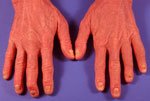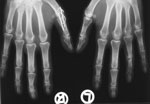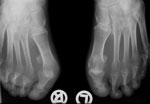Severe Psoriatic Erythroderma and Disabling Mutilating Arthritis in HIV-Positive Patient
Matilda Bylaite and Thomas Ruzicka
Department of Dermatology, Heinrich-Heine-University Duesseldorf, Duesseldorf, Germany
History
An HIV-positive 50-year-old heterosexual white man presented with a 6-week history of exacerbation of psoriasis with erythroderma and painful, diffusely swollen and deformed fingers, toes, knees and right shoulder. He and his girlfriend were both diagnosed HIV-positive in 1986. His risk factors include a 15-year history of intravenous drug abuse and sexual contact with his girlfriend who had previously received a blood transfusion. The patient has been in the methadone program since 1997, and recently he receives an opioid, Oxycodonâ . In 1995, during antiretroviral monotherapy with zalcitabine, he developed scalp psoriasis and psoriatic onychodystrophy involving all 20 nails. Afterwards, a severe flare of widespread, confluent, deep red psoriatic plaques involved his entire skin, particularly affecting his face, trunk, axillae, groin, genitals and extremities, especially the dorsal aspect of the hands and feet (Fig. 1). Within the next 2 years, the patient developed rapidly progressive, deforming distal interphalangeal arthropathy of his fingers and toes. Highly active antiretroviral therapy (HAART) with didanosine, stavudine and ritonavir were initiated in 1997. His peripheral HIV load was 33,852 copies/ml (measured by polymerase chain reaction, HIV-PCR), CD4 cell count was 342/µl, CD8 lymphocytes were 2,326/µl, and CD4/CD8 ratio was 0.15. He was then diagnosed with acquired immunodeficiency syndrome (AIDS) stage IV C2 (World Health Organization). When ritonavir was changed to lamivudine in 2000 due to progression of his HIV infection, the skin lesions and infection parameters improved but the arthritis symptoms progressed. Thus, since 1995, he was regularly treated (2-3 times/year) in our clinic for an exacerbation of psoriatic skin lesions and severe progressing disabling arthropathy. In addition to HAART, his therapeutic regimen included topical antipsoriatics, such as keratolytics, greasy emollients, potent steroids and vitamin D3 analogues, UVB and UVA1 therapy. Systemically he had been treated with steroids, short-term low-dose methotrexate, concomitantly with nonsteroidal antiinflammatory drugs. In the last year, his psoriatic arthritis has progressed to involve additional joints, and his worsening general condition due to severe pain, swelling and joint deformities necessitated the use of a wheelchair. Five months ago, methotrexate 15 mg weekly was initiated and was stopped after 2 months because it was unclear whether the methotrexate had an effect on the development of an ulcer on his right arm. Additionally, he had a chronic hepatitis C, persistent oral candidiasis and wasting syndrome due to his HAART for HIV infection. The patient’s family history was significant for late-onset nummular psoriasis involving his sister.
| Fig. 1. Severe onset of psoriasis in HIV-infected patient. |
 |

  |
Clinical Findings
On physical examination, cachexia (178 cm, 49.3 kg) and lipoatrophy of the face, arms, legs and buttocks with prominence of veins due to HAART were evident. His entire skin including scalp presented as a large, universally inflamed, erythrodermic, pruritic and fine scaling psoriatic patch (Fig. 2). White-creamy plaques without evident ulcers were spread over oral mucous membranes. All 20 nails were dyskeratotic, yellowish and pitted. The distal interphalangeal joints of his hands and especially toes were deformed, erythematous, edematous and tender, resulting in so-called sausage digits (Figs. 3 and 4). There was an increase in severity of pain with an active motion. Both knees and right shoulder were also symptomatic. Finally, generalized lymphadenopathy, hepatomegaly and splenomegaly were palpable.
| Fig. 2. Psoriatic erythroderma in HIV-positive patient. Note lipoatrophy, a so-called wasting syndrome, due to HAART. |
 |

  |
| Fig. 3. Psoriatic mutilating arthritis associated with severe nail dystrophy in HIV-positive patient. |
 |

  |
| Fig. 4. Psoriatic mutilating arthritis in HIV-positive patient with striking joint swelling and deformed digits. |
 |

  |
Histopathology
Histopathological examination of a biopsy for a right inguinal lymph node showed unspecific chronic lymphadenitis without malignancy. Examination and Laboratory Findings
Laboratory studies revealed mild anemia (Hb 11.5 g/dl, Ht 39.1%) and leukocytosis (12.2 K/Ul); CRP was only 1.0 mg/dl. Other routine laboratory tests, including liver and renal function studies were within normal limits except for positive serological results for hepatitis C. Serological test for rheumatoid factor was negative. His infection parameters showed a CD4 lymphocyte cell count of 437/ µl, CD8 lymphocytes of 2141/µl, and CD4 ⁄ CD8 ratio was 0.2. The plasma HIV-RNA level was 900 Eq/ml. Cultures from scrapings of the mouth were positive for Candida albicans. Systemic examination showed no other opportunistic infections or systemic disorders except for lymphadenopathy, hepatomegaly and splenomegaly due to HIV and chronic hepatitis C infection. Radiographic examination of the hands (Fig. 5), feet (Fig. 6), knees and shoulders revealed osteoporosis, narrowing of the joint spaces and marginal erosions, gross osteolysis of left hand IV proximal and right III distal interphalangeal, and all phalanges of the feet demonstrated bony ankylosis and digital foreshortening. Arthrodesis was noted in his proximal interphalangeal joint of the right thumb. The radiological findings confirmed the diagnosis of progressive mutilating arthritis of hands and feet.
| Fig. 5. Psoriatic mutilating arthritis in HIV-associated patient. Bone osteolysis results in joint ankylosis. Note arthrodesis of the right thumb. |
 |

  |
| Fig. 6. Psoriatic mutilating arthritis in HIV-associated patient. Gross osteolysis of metatarsal heads and phalanges. |
 |

  |
Diagnosis
Based on previous history, clinical, laboratory and radiological findings a diagnosis of severe psoriatic erythroderma, associated with progressive psoriatic mutilating arthritis and onychodystrophy in an HIV infected patient (CDC C2, World Health Organization) with Candida stomatitis and chronic hepatitis C was established. Therapy and Course
Initially, topical treatment with emollients and potent steroid the mometasone furoate (Ecural® ) 0.1% ointment was started. In addition to HAART (didanosine, stavudine and lamivudine daily) and Oxycodon® , UVA1 therapy 3 times weekly, combined with oral prednisolone 20 mg daily and the nonsteroidal antiinflammatory drug ibuprofen 400 mg b.i.d, as well as physiotherapy were initiated. Oral ketoconazole 100 mg daily was administered for oral candidiasis. As mutilating arthritis was symptomatic and progressively disabling, while an HIV consultant confirmed that HIV infection and its management was stable (as CD4 lymphocyte cell count and virus load was also stable), low-dose intravenous therapy with methotrexate 15 mg weekly was initiated. Two weeks later, no signs of virus replication or worsening of any laboratory parameters were noted. Within the first few days, our patient noted a symptomatic improvement of psoriatic arthropathy and resolution of erythroderma. His general condition also improved. The patient was suggested to continue the same therapeutic regimen, including topical antipsoriatics, UVA1 and oral therapy with MTX (15 mg weekly) in combination with tapering and discontinuation of oral prednisolone (20 mg daily). Regular follow-up for HIV-associated mutilating arthritis and possible opportunistic infections, due to therapy with immunosuppressants, were established. Discussion
Psoriasis, a common chronic inflammatory papulosquamous skin disorder, affects both sexes equally in 1-2% of the general population. The incidence of developing psoriasis among patients with HIV infection and AIDS is estimated to be higher than in uninfected persons (1). Furthermore, there is a six-fold increase in psoriatic arthritis in HIV-positive patients with psoriasis compared with HIV-negative patients with psoriasis (2). Psoriasis may appear de novo or exhibit a sudden and severe worsening of preexisting disease in HIV infected patients (3, 4). Although etiopathogenesis of psoriasis remains unclear, its association with HIV infection appears even more complicated. The immune system plays an important role and the imbalance of T cells in HIV infection, involving the depletion of CD4 T cells and the activation and proliferation of CD8 T cells may facilitate the development of psoriatic symptoms (5, 6). Environmental factors, along with dysregulation of the immune system due to HIV infection, allow opportunistic infections to trigger the disease in genetically predisposed persons (3). Recently, several reports demonstrated HLA-Cw*0602 to play an important role in the predisposition to HIV-associated psoriasis (6). It is also believed that HIV itself may trigger psoriasis since significant improvement during zidovudine therapy was observed (7). The clinical presentation of HIV-associated psoriasis differs from that of classical psoriasis by its sudden onset, extremely severe course with multiple flares, usually negative family history and resistance to therapy (2). Psoriatic lesions are more erythematous, itchy or even painful, and extensive in distribution. The disease particularly affects the face, flexures and extremities often with pustules and severe onychodystrophy and arthropathy (3). The course of psoriatic arthritis in HIV-positive patients is more progressive and quickly results in marked deformities (2, 3). Mutilating arthritis is generally a relatively uncommon, severely deforming arthritis that predominantly involves the fingers and toes, resulting in a symptomatic deformity and functional impairment of the hands or feet. Therapy of HIV-associated psoriasis must be adjusted to the clinical presentation and patient’s immune status. HAART should be initiated immediately since it slows the progression of HIV infection and increases life expectancy (5, 7). It has also been shown to reverse HIV-related skin disorders. However, skin lesions become more severe with low CD4 counts and HIV progression (8). Often, antiretroviral therapy, especially in combination with zidovudine, reduces the severity of psoriatic lesions and symptoms, particularly in the first year of treatment (7, 9). Lately, antiretroviral therapy with zalcitabine and ritonavir was also observed to improve psoriasis in HIV-positive patients (10). Topical antipsoriatic measures, such as keratolytics, topical corticosteroids, calcipotriol or tazarotene should be tried first, however, in many cases they are of little benefit (4). Phototherapy in HIV-infected patients is controversial and poorly understood. Both UVB and PUVA are effective but potentially immunosuppressive and may hasten HIV replication and the decline in CD4 T-cell count in vitro or in animals (11-13). However, it was shown that UVB might be more efficient in HIV activation in human skin than PUVA (14, 15). Narrowband UVB and UVA1 is preferable and probably less harmful than other measures (16). Systemic therapy is usually indicated for severe course or arthropathic forms of HIV-associated psoriasis. Both skin and joint manifestations of psoriasis in most HIV infected patients may respond to systemic retinoids, such as acitretin or etretinate. Previously, immunosupressive agents such as methotrexate or ciclosporin were contraindicated for treatment of severe psoriasis in HIV infection since they could potentiate opportunistic infections and accelerate HIV disease (4). However, other authors suggest that the absolute contraindication to the use of methotrexate in HIV-infected patients should be reevaluated (17). Similar results have been noticed with ciclosporin (18) and corticosteroid therapy (19). Recently, both skin and joint symptoms were reported to improve in HIV infected patients receiving TNF-α antagonists such as infliximab (20) and etanercept (21).We present a case of long-term followed-up severe psoriasis and mutilating arthritis in an HIV-infected patient. Probably, an optimal antiretroviral therapy during 18 years of HIV infection allowed his condition to remain stable without presentation of other opportunistic infections. Herein, our patient showed good respond to UVA1 and low-dose methotrexate therapy in combination with low-dose oral steroids and topical antipsoriatic agents. However, an unexpected onset of severe skin disorders should alert physicians of morbidity due to HIV infection and may even be more disabling than Kaposi’s sarcoma (7). Despite the fact that severe psoriasis and disabling arthropathy is progressive and current therapies cannot provide a permanent cure, reduction of psoriatic and arthritic symptoms while maintaining stable viremia with a constant CD4 cells count in our patient was temporarily achieved. References
1. Badge,r J., Berger, T.G., Gambia, C., Koo, J.Y. HIV and psoriasis. Clin Rev Allergy Immunol 1996, 14: 417-31.
2. Reveille, J.D., Conant, M.A., Duvic, M. Human immunodeficiency virus-associated psoriasis, psoriatic arthritis, and Reiter’s syndrome: A disease continuum? Arthritis Rheum 1990, 33: 1574-8.
3. Johnson, T.M., Duvic, M., Rapini, R.P., Rios, A. AIDS exacerbates psoriasis [letter]. N Engl J Med 1985, 313: 1415.
4. Duvic, M., Johnson, T.M., Rapini, R.P. et al. Acquired immunodeficiency syndrome-associated psoriasis and Reiter’s syndrome. Arch Dermatol 1987, 123: 1622-32.
5. Fischer, T., Schworer, H., Vente, C. et al. Clinical improvement of HIV-associated psoriasis parallels a reduction of HIV viral load induced by effective antiretroviral therapy. AIDS 1999, 13: 628-9.
6. Mallon, E., Young, D., Bunce, M. et al. HLA-Cw*0602 and HIV-associated psoriasis. Br J Dermatol 1998, 139: 527-33.
7. Duvic, M., Crane, M.M., Conant, M. et al. Zidovudine improves psoriasis in human immunodeficiency virus-positive males. Arch Dermatol 1994; 130:447 – 451.
8. Muñoz-Pérez, M.A., Rodrigues-Pichardo, A., Camacho, F., Colmenero, M.A. Dermatological findings correlated with CD4 lymphocyte counts in a prospective 3 year study of 1161 patients with human immunodeficiency virus disease predominantly acquired through intravenous drug abuse. Br J Dermatol 1998, 139: 33-9.
9. Diez, F., del Hoyo, M.L., Serrano, S. Zidovudine treatment of psoriasis associated with acquired immunodeficiency syndrome. J Am Acad Dermatol 1989, 20: 76-82.
10. Berthelot, P., Guglielminotti, C., Frésard, A. et al. Dramatic cutaneous psoriasis improvement in a patient with the human immunodeficiency virus treated with 2, 3-dideoxycytidine and ritonavir [letter]. Arch Dermatol 1997, 133: 531.
11. Valerie, K., Delers, A., Bruck, C. et al. Activation of human immunodeficiency virus type 1 by DNA damage in human cells. Nature 1988, 333: 78-81.
12. Vogel, J., Cepeda, M., Tschachler, E., Napolitano, L.A., Jay, G. UV activation of human immunodeficiency virus gene expression in transgenic mice. J Virol 1992, 66:1-5.
13. Zmudzka, B.Z., Beer, J.Z. Activation of human immunodeficiency virus by ultraviolet radiation. Photochem Photogene 1990, 52: 1153-62.
14. Morison, W.L. PUVA therapy is preferable to UVB phototherapy in the management of HIV-associated dermatomes. Photogene 1996, 64: 267-8.
15. Stern, R.S., Mills, D.K., Krill, K. et al. HIV-positive patients differ from HIV-negative patients in indications for and type of UV therapy used. J Am Acad Dermatol 1998, 39: 48-55.
16. Beer, J.Z., Olvey, K.M., Lee, W., Zmudzka, B.Z. Reassessment of the differential effects of ultraviolet and ionizing radiation on HIV promoter: the use of cell survival as the basis for comparisons. Photochem Photobiol 1994, 59: 643-9.
17. Maurer, T.A., Zackheim, H.S., Tuffanelli, L., Berger, T.G. The use of methotrexate for treatment of psoriasis in patients with HIV infection. J Am Acad Dermatol 1994, 31: 372-5.
18. Allen, B.R. Use of cyclosporin for psoriasis in HIV-positive patient [letter]. Lancet 1992, 339: 686.
19. Andrieu, J.M., Lu, W., Levy, R. Sustained increases in CD4 cell counts in asymptomatic human immunodeficiency virus type-1 seropositive patients treated with prednisolone for 1 year. J Infect Dis 1995, 171: 523-30.
20. Bartke, U., Venten, I., Kreuter, A. et al. Human immunodeficiency virus-associated psoriasis and psoriatic arthritis treated with infliximab. Br J Dermatol 2004, 150: 770-95.
21. Aboulfa, D.M., Bundow, D., Wilske, K., Ochs, I. Etanercept for treatment of human immunodeficiency virus-associated psoriatic arthritis. Mayo Clin Proc 2000, 75: 1093–8. |